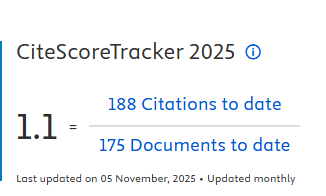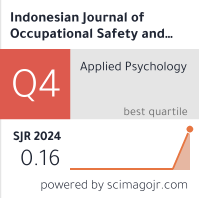The Correlation between Physical Workload and the Increase in Workers' Pulse Rate
Downloads
Introduction: The workload that exceeds individual work capacity will increase the pulse rate rapidly. The purpose of this research was to study the correlation between physical workload and the increase in workers' pulse rate. Methods: This research utilized cross-sectional design by using the observational method with 23 workers from the BRF area of PT X Sidoarjo as respondents. This research was conducted by conducting the direct observation by calculating the workload received by the worker by using %CVL method and calculating the resting and working heart rates. Results: The result showed that all workers were male and had the productive age distribution of 60.9% in the age range of 25-50 years. Based on the calculation of workload, the majority of workers have the workload on the moderate %CVL category, amounting to 56.5%. Based on the measurement of the resting and working heart rates, it was found that all workers experienced the pulse rate increase. Based on the result of Pearson correlation statistical test, the result was p<0.05, which means that there was a significant correlation between the workload and the increase in the workers' pulse rate. Moreover, the correlation coefficient was 0.911, that indicated a very strong and positive correlation. Conclusion: This research concludes that there is a strong and positive correlation between workload and the increase in the workers' pulse rate.
Keywords: %CVL, cardiovascular load, workload, pulse rate
Ambarwati, F. R. (2014) The Concept of Basic Human Needs. Yogyakarta: Parama Ilmu.
Atiqoh, J., Wahyuni, I. and Lestyanto, D. (2014) ‘Factors Associated with Work Fatigue in Workers Convection Section Tailoring at CV. Aneka Garment Gunungpati Semarang', Jurnal Kesehatan Masyarakat FKM Undip, 2(2), pp. 119–126.
Fahamsyah, D. (2017) ‘Analysis of Relationship between Mental Workload and Job Stress', The Indonesian Journal of Occupational Safety and Health, 6(1), pp. 107–115.
Grandjean, E. (1993) Fitting the Task to the Man. 4th edn. London: Taylor & Francis Inc.
Hendra (2003) Factors That Affect the Increasing of Body Core Temperature and Heart Rate on Workers Exposed by Heat (Case Study at Cor Department, Tempa and Cor Division, PT Pindad (Persero), Bandung 2003). Thesis. Depok: Master in Public Health Sciences, Universitas Indonesia.
Kurniawan, D. (1995) ‘Significance of the Working Pulse as a Parameter for Loading', Majalah Hiperkes dan Keselamatan Kerja XXVIII (2), pp. 20–25.
Lestya, D. W. N., Rachman, F. and Wiediartini (2016) ‘Analysis of External and Internal Factors Affecting Physical Workloads on Finishing Work in Steel Fabrication Companies', in Proceeding 1st Conference on Safety Engineering and Its Application, pp. 24–28.
Maharja, R. (2015) ‘Analsys of Level of Work Fatigue based on Physical Workload of the Nurses in Inpatient Care Unit of RSU Haji Surabaya', The Indonesian Journal of Occupational Safety and Health, 4(1), pp. 93–102.
Mei, E. D. (2010) Effect of Work on Charges in Labor Pulse Mechanical Part in PT. Indo Acidatama, Tbk. Kemiri, Kebakkramat, Karanganyar. Undergraduate Thesis. Surakarta: Facuty of Medicine, Universitas Sebelas Maret.
Moeljosoedarma, S. (2008) Higiene Industri. Jakatra: Faculty of Medicine, Universitas Indonesia.
Nurmianto, E. (2004) Ergonomics: Basic Concepts and Applications. Surabaya: Guna Widya.
Purwaningsih, R. and Aisyah (2016) ‘Analysis the Effect of Temperatur, Body Weights, and Work Load to Heart Pulse Level of Airport Ground Handling Worker', Jurnal Teknik Industri, 11(1), pp. 15–20.
Rahadian, R. R. (2016) The Relationship between Heat Pressure and Workload with Increasing the Pulse Rate of Workers in the BRF and TFH Work Areas at PT. X. Undergraduate Thesis. Surabaya: Faculty of Public Health Universitas Airalngga.
Rizqiansyah, M. Z. A., Hanurawan, F. and Setiyowati, N. (2017) ‘Relationship between Physical Workload and Ergonomics-Based Mental Workload Against Work Saturation Levels at Employees of PT Jasa Marga (Persero) Tbk Surabaya Branch Gempol', Jurnal Sains Psikologi, 6(1), pp. 37–42.
Sandi, I. N. (2016) ‘Effect of Physical Exercise on The Pulse Rate', Sport and Fitness Journal, 4(2), pp. 1–6.
Santoso, G. (2004) Safety Management and Occupational Health. Jakarta: Prestasi Pustaka.
Setyaningsih, L. (2007) Work Stress on Teacher Viewed from the Social Support and Work Period. Undergraduate Thesisi. Semarang: Faculty of Psychology Universitas Katolik Soegijapranata.
Stariszky, O., Ekawati and Jayanti, S. (2016) ‘The Correlation between Work Load and Work Climate with Fatigue in Land Surveying Job using Theodolite.', Jurnal Kesehatan Masyarakat FKM Undip, 4(3), pp. 549–556.
Tarwaka (2015) Industrial Ergonomics: Basics of Ergonomics Knowledge and Applications at Work. 2nd edn. Surakarta: Harapan Press.
Tasyrifah, G. M. (2017) The Difference Level of Dehydration and Fatigue on Exposure Labor by Hot Working Climate at PT. Panen Boyolali. Undergraduate Thesis. Surakarta: Faculty of Health Science, Universitas Muhammadiyah Surakarta.
Yoopat, P., Toicharoen, P., Glinsukon, T., Vanwonterghem, K., Louhevaara, V. (2002) ‘Ergonomics in practice: Physical workload and heat stress in thailand', International Journal of Occupational Safety and Ergonomics, 8(1), pp. 83–93.

In order to be accepted and published by The Indonesian Journal of Occupational Safety and Health, Author(s) who submit an article should complete all the review process. The copyright of received articles assigned to the The Indonesian Journal of Occupational Safety and Health and Department of Safety and Health, Universitas Airlangga as publishers of the journal. The intended copyright includes the rights to publish articles in various forms (including reprints).
The Editorial Team of The Indonesian Journal Of Occupational Safety and Health and Department of Safety and Health strive to ensure that no errors occur in the articles that have been published, both data errors and statements in the article.
Users of this website will be licensed to use materials from this website following the Creative Commons Attribution-NonCommercial-ShareAlike 4.0 International License. No fees charged. Please use the materials accordingly.
------------------------------------------------------------------------------------------------------------------------------------------------------------------------------------------
Attribution ” You must give appropriate credit, provide a link to the license, and indicate if changes were made. You may do so in any reasonable manner, but not in any way that suggests the licensor endorses you or your use.
NonCommercial ” You may not use the material for commercial purposes.
ShareAlike ” If you remix, transform, or build upon the material, you must distribute your contributions under the same license as the original.







 How to Submit Articles in OJS
How to Submit Articles in OJS

























